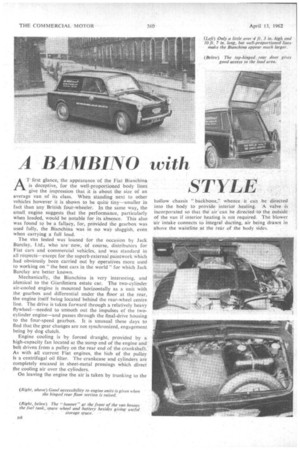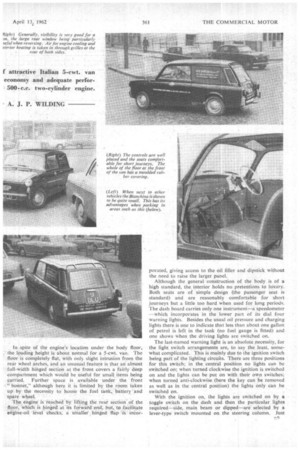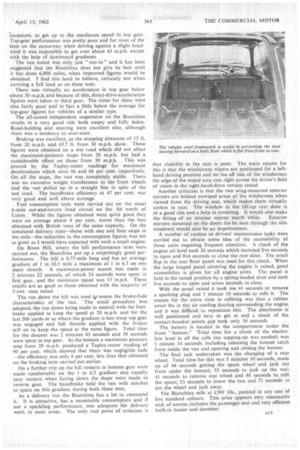BAMBINO with STYLE
Page 58

Page 59

Page 60

Page 65

If you've noticed an error in this article please click here to report it so we can fix it.
ATfirst glance, the appearance of the Fiat Bianchina is deceptive, for the well-proportioned body lines give the impression that it is about the size of an average van of its class. When standing next to other vehicles however it is shown to be quite tiny—smaller in fact than any British four-wheeler. In the same way, the small. engine suggests that the performance, particularly when loaded, would be notable for its absence. This also was found to be a fallacy, for, provided the gearbox was used fully, the Bianchina was in no way sluggish, even when carrying a full load.
The van tested was loaned for the occasion by Jack Barclay, Ltd.,, who are rioiv, of course, distributors for Fiat cars and commercial vehicles, and was standard in all respects—except for the superb external paintwork which had obviously been carried out by operatives more used to working on "the best cars in the world" for which Jack Barclay are better known.
Mechanically, the Bianchina is very interesting, and identical to the Giardiniera estate car. The two-cylinder air-cooled engine is mounted horizontally as a unit with the gearbox and differential under the floor at the rear, the engine itself being located behind the rear-wheel centre line. The drive is taken forward through a relatively heavy flywheel—needed to smooth out the impulses of the twocylinder engine—and passes through the final-drive housing to the four-speed gearbox. It is unusual these days to find that the gear changes are not synchronized, engagement being by dog clutch.
Engine cooling is by forced draught, provided by a high-capacity fan located at the sump end of the engine and belt driven from a pulley on the rear end of the crankshaft. As with all current Fiat engines, the hub of the pulley is a centrifugal oil filter. The crankcase and cylinders are completely encased in sheet-metal pressings which direct the cooling air over the cylinders.
On leaving the engine the air is taken by trunking to the hollow chassis "backbone," whence it can be directed into the body to provide interior heating. A valve is incorporated so that the air can be directed to the outside of the van if interior heating is not required. The blower 'air intake connects to integral ducting. air being drawn in above the waistline at the rear of the body sides.
In spite of the engine'slocation under the body floor, the loading height is about normal for a 5-cwt. van. The floor is completely flat, with only slight intrusion from the rear wheel arches, and an unusual feature is that an almost full-width hinged section at the front covers a fairly deep compartment which would be useful for small items being carried. Further space is available under the front " bonnet," although here it is limited by the room taken up by the necessity to house the fuel tank", battery and spare wheel.
The engine' is reached by lifting the rear section of the floor, which is hinged at its forwardend, but, to .facilitate engine-oil level cheeks, a smaller.. hinged flap "is .in-Cor
porated, giving access to the oil filler and dipstick without the need. to raise the larger panel.
Although the general construction of the body is of a high standard, the interior holds no pretentions to luxury. Both seats are of simple design (the passenger seat is standard) and are reasonably comfortable for short journeys but a little too hard when used for long periods. The dash board carries only one instrument—a speedometer —which incorporates in the lower part of its dial four warning lights. Besides the usual oil pressure and charging lights there is one to indicate that less than about one gallon of petrol is left in the tank (no fuel gauge is fitted) and one shows when the driving lights are switched on.
The last-named warning light is an absolute necessity, for the light switch arrangements are, to say the least, somewhat complicated. This is mainly due to the ignition switch being part of the lighting circuits. There are three positions for this switch; in the central position no lights can be switched on; when turned clockwise the ignition is switched on and the lights can be put on with their own switches; when turned anti-clockwise (here the key can be removed as well as in the central position) the lights only can be switched on.
With the ignition on, the lights are switched on by a toggle switch on the dash and then the particular lights required—side, main beam or dipped—are selected by a lever-type switch mounted on the steering column, Just above this switch is the trafficator switch which is of the same type but has a shorter lever. The switch for the twin windscreen wipers is also mounted on the dash, and it was a surprise to find that the wiper circuit was not connected to the ignition.
Both the choke and starter controls differ from the conventional, operation of them being by levers mounted next to each other between the seats, just in front of the handbrake lever. A useful fitting is a hand-throttle control mounted under the dash, beneath a small cubby hole.
Driving the Bianchina was an interesting and, to a certain extent, a pleasant experience. There was, of course, very little power available-maximum power output of the engine is only 17.5 b.h.p. net at 4,600 r.p.m. and maximum net torque only 21.7 lb.-ft. at 3,200 r.p.m. This was most noticeable at low revs, and meant that the revs, had to be kept up for a nimble performance. Once this was accepted the van was able to hold its own with London's traffic, although gear changes had to be made almost continuously to do so.
nI0 Because of this it was fortunate that the gear-change action is first-class, even though there is no synchromesh. Double declutching produced the cleanest change, naturally, but it was not essential, and there was only a slight noise when changes were made with a single clutch depression. It was actually possible to make upward as well as downward gear-changes keeping full-throttle applied.
This method was used for the acceleration tests through the gears, and although the figures obtained are below average for this capacity of van, they are not too bad considering the size of engine. ,First, second and third gears were needed for these runs, the maximum speeds in the lower two (19 and 30 m.p.h.) being reached before changes up were made. Maximum speeds in third and top were checked on the M1 motorway. These were found to be 45 and 53 m.p.h. respectively. The speeds quoted take into account a speedometer inaccuracy of 6-per cent. fast at 30 m.p.h. and 10 per cent. fast at 60 m.p.h.
It was found difficult, and possible only on rare occasions, to get up to the maximum speed in top gear. Top-gear performance was pretty poor and for most of the time on the motorway when driving against a slight headwind it Was impossible to get over about 43 m.p.h. except with the help of downward gradients.
The van tested was only just "run-in" and it has been suggested that the Bianchina does not give its best until it has done 6,000 miles, when improved figures would be obtained. I find this hard to believe, certainly not when carrying a full load as on these tests.
There was virtually no acceleration in top gear below • about 30 m.p.h. and because of this, direct-drive acceleration figures were taken in third gear. The times for these were also fairly poor and in fact a little below the average for top-gear figures for vehicles of a similar type.
The all-round independent suspension on the Bianchina results in a very good ride both empty and fully laden. Road-holding and steering were excellent also, although there was a tendency to over-steer.
Braking was excellent, as the stopping distances of 15 ft. from 20 m.p.h. and 45.7 ft. from 30 m.p.h. show. These figures were obtained on a wet road which did not affect the maximum-pressure stops from 20 m.p.h. but had a considerable effect on those from 30 m.p.h. This was proved by the Tapley-meter. readings for maximum decelerations which were 96 and 66 per cent. respectively. On all the stops, the van was completely stable. There was no excessive weight transference to the front wheels and the van pulled up in a straight line in spite of the wet road. The handbrake efficiency at 47 per cent. was very good and well above average.
Fuel consumption tests were carried out on the usual 6-mile out-and-return road circuit on the A6 north of Luton While the figures obtained were quite good they were on average about 8 per cent. worse than the best obtained with British vans of the same capacity. On the simulated delivery runs—those with one and four stops to the mile—the reduction in the consumption figures was not as great as I would have expected with such a small engine.
On Bison Hill, where the hill performance tests were carried out, the Bianchina put up a surprisingly good performance. The hill is 0.75-mile long and has an average gradient of 1 in 10.5 with a maximum of 1 in 6.5 on one short stretch. A maximum-power ascent was made in 2 minutes 22 seconds, of which 24 seconds were spent in first gear, and the minimum speed was 15 m.p.h. These results are as good as those obtained with the majority of 5-cwt. vans tested.
The run down the hill was used tp assess the brake-fade characteristics of the van. The usual procedure was adopted, the run down being made in neutral with the footbrake applied to keep the speed at 20 m.p.h. and for the last 200 yards or so where the gradient is less steep top gear was engaged and full throttle applied with the brakes still on to keep the speed at the same figure. Total time for the descent was 2 minutes 43 seconds and 38 seconds were spent in top gear. At the bottom a maximum pressure stop from 20 m.p.h. produced a Tapley-meter reading of 90 per cent. which showed that there was negligible fade —the efficiency was only 6 per cent. less than that obtained on the braking tests carried out earlier.
On a further trio up the hill restarts in bottom gear were made comfortably on the I in 6.5 gradient and equally easy restarts when facing down the slope were made in reverse gear. The handbrake held the van with notches to spare on this gradient during both these tests.
As a delivery van the Bianchina has a lot to commend it. It is attractive, has a reasonable consumption and if not a sparkling performance, one adequate for delivery work in most areas. The only real point of criticism is
that visibility in the rain is poor. The main reason for this is that the windscreen wipers are positioned for a lefthand driving position and on the off side of the windscreen the edge of the wiped area cuts right across the driver's field of vision in the right-hand-drive version tested.
Another criticism is that the two wing-mounted exterior mirrors are behind unwiped areas of the windscreen when viewed from the driving seat, which makes them virtually useless in rain. The window in the lift-up rear door is of a good size and a help in reversing. It would also make
the fitting of an interior mirrorworth while. Exterior mirrors mounted on the doors (to be seen through the side windows) would also be an improvement.
A number of•routine or drivers' maintenance tasks were carried out to obtain some idea of the accessibility of those units requiring frequent attention. A check of the -engine oil level took 26 seconds which included five seconds to open and five seconds to close the rear door. The small flap in the rear floor panel was used for this check. When the lailge hinged panel covering the engine is raised, good accessibility is given for all engine units. The panel is held in the raised position by a spring-loaded strut and took five seconds to open and seven seconds to close
With the panel raised it took me 41 seconds to remove a sparking plug and 1 minute 16 seconds to refit it. The reason for the extra time in refitting was that a rubber cover fits in the air cooling ducting surrounding the engine and it was difficult to reposition this. The distributor is well positioned and easy to get at and a check of the contact-breaker points gap took only 56 seconds.
The battery is located in the compartment under the front "bonnet." Total time for a check of the electrolyte level in all the cells (no topping-up was needed) was 1 minute 34 seconds, including releasing the bonnet catch from inside the van and opening and closing the bonnet.
The final task undertaken was the changing of a rear wheel. Total time for this was 5 minutes 10 seconds, made up of 44 seconds getting the spare wheel and jack out froth under the bonnet; 55 seconds to jack up the van; 41 seconds to remove one wheel and 46 seconds to refit the spare;, 53 seconds to lower the van and 71 seconds to put the wheel and jack away. The Bianchina sells at £399 10s., painted in any one of five standard colours. This price appears very reasonable and, of course, includes the passenger seat and very efficient built-in heater and demister.




















































































































